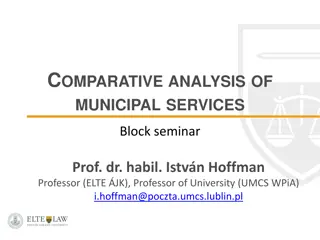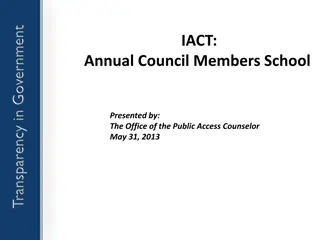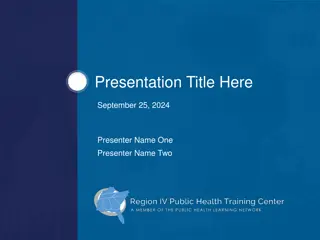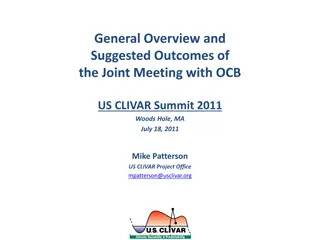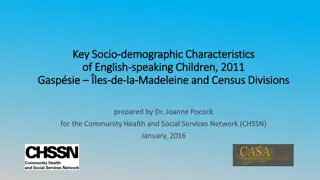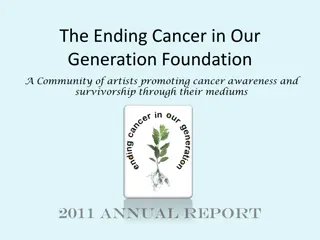
Blackford County Concerned Citizens - Community Health Advocacy
Learn about Blackford County Concerned Citizens and their mission to investigate diseases, improve public health, and advocate for community wellness. Get involved in promoting a safe and healthy future for the residents of Blackford County.
Download Presentation

Please find below an Image/Link to download the presentation.
The content on the website is provided AS IS for your information and personal use only. It may not be sold, licensed, or shared on other websites without obtaining consent from the author. If you encounter any issues during the download, it is possible that the publisher has removed the file from their server.
You are allowed to download the files provided on this website for personal or commercial use, subject to the condition that they are used lawfully. All files are the property of their respective owners.
The content on the website is provided AS IS for your information and personal use only. It may not be sold, licensed, or shared on other websites without obtaining consent from the author.
E N D
Presentation Transcript
Public Education Meeting May 21, 2011 1:00 Hartford City, IN
We are not here to curse We are not here to curse the darkness, but to light the darkness, but to light the candle that can guide the candle that can guide us through that darkness us through that darkness to a safe and sane future. to a safe and sane future. ~ ~John F. Kennedy~ John F. Kennedy~
The mission of Blackford County Concerned Citizens is to improve the quality of life of Blackford County s residents by reducing the incidence of diseases, primarily through citizen action to investigate the diseases that are prevalent and by advocating to have these diseases investigated
Founding Members Katherine Castelo Kathy Schrope Dunsmore Joseph Castelo
History of BCCC May 2010- met with Indiana Department of Health December 2011-met with the Hoosier Environmental Council and the IU School of Public Health
BCCC Contact info Facebook/Blackford County Indiana Cancer Action Group BlackfordCountyConcernedCitizens.com BlackfordCountyConcernedCitizens@yahoo.com
What is happening in Blackford County? A summary of knowledge relating to disease and the environment
State Cancer Incidence Cancer Incidence by County Blackford County 700 650 600 Cancer Incidence #/100,000 550 500 Blackford rate: 535.3 State Avg: 457.2 Std Dev: 39.5 450 400 350 300 250 200 Brown Warren Switzerland Perry Hamilton DeKalb Montgomery Henry Porter Hancock Crawford St. Joseph Miami Sullivan Pulaski Benton County of Indiana Years 2002-2006 Source: http://statecancerprofiles.cancer.gov/incidencerates/index.php?stateFIPS=18&cancer=001&race=00&sex=0&age=001&type=incd&so rtVariableName=rate&sortOrder=default
Cancer Incidence Report from Indiana Department of Health Cancers sites that were statistically higher than the state average All Cancer Sites Colon, rectum and anus Lung and Bronchus Malignant Lymphoma Thyroid and Other Endocrine Glands Bladder Interim Report on Blackford County, Indiana Cancer Incidence Prepared by: Public Health Geographics, Epidemiology Resource Center Indiana State Department of Health Apriil 12th, 2010
Sampling from State Report Years Expected # of Cases 202.8 18.1 28.5 32.9 30.5 13.6 Actual # of Case 239 32 40 56 44 25 All Sites Bladder Colon Lung Lymphoma Thyroid 2001-2005 2001-2005 2003-2005 2001-2005 1997-2006 1998-2007
Cancer Incidence by County US Indiana Blackford Deleware 479.4 536.9 113.8 86.9 137.5 152.3 79.8 95.8 52.2 63.8 Grant 535.7 106.6 163.5 84.1 53.1 Henry 508.9 114.3 118.9 87.2 65.9 Jay Madison 504.2 116.2 105.3 91 56.5 Wayne 499.1 106.9 122.2 97.3 51.6 All Cancer Sites Female Breast Prostate Lung and Bronchus Colorectal 473.7 125.1 159.2 69.5 52.6 492 469.3 109.1 142 84.1 43.6 117.2 152 81.3 53.4 Red-highest rate in compared counties Blue-second highest rate in compared counties State Cancer Profiles by National Cancer Institute Years 2003-2007
Issues with Data Small Population Data lags behind Latest data analyzed was 2007 Inaccurate Reporting People seeking treatment else where Long term residents who move before diagnosis
What is Cancer? A name for a group of more than 100 diseases where cells grow out of control Cancer cell growth is different than normal cell growth. Cancer cells don t die Cancer cells can invade other tissues Cells become cancer cells when DNA is damaged Some damage is inherited but most is caused while a normal cell is reproducing or from something in the environment
What Causes Cancer? Tobacco Overweight or Obesity Physical inactivity and nutrition Infectious Agents E.g. HPV, HIV Heredity Ultraviolet Light Environmental Factors Source: American Cancer Society, Cancer Facts & Figures 2008
Who Gets Cancer? Anyone can get cancer One of the biggest factors that can make a person more likely to get cancer is age: 3 out of 4 cancers are found in people age 55 or older. Half of all men and one-third of all women in the US will develop cancer during their lifetimes There are many other factors that affect cancer risk and some of them can be changed
Colon Cancer The 3rd most common cancer in both men and women in the U.S. 3rd leading cause of cancer-related death in the U.S. At least half of all cases could be prevented by regular testing Non-controllable risk factors include age and family history Controllable risk factors include diet, smoking, overweight, heavy alcohol use, physical activity
Colon Cancer Risk Factors Diets that are high in red meats and processed meats Obesity Smoking Heavy alcohol use Type 2 diabetes
Lung Cancer Lung cancer is the second most common cancer in both men and women It accounts for 15% of all new cancers Lung cancer is the leading cause of cancer death among both men and women in the U.S. More people die of lung cancer than of colon, breast, and prostate cancers combined Lung cancer mainly occurs in older people For smokers, the risk is much higher
Lung Cancer Risk Factors Smoking Radon Exposure to second hand smoke Work place exposure to asbestos Cancer causing agents in the workplace Radioactive ores Inhaled chemicals such as arsenic, silica, vinyl chloride, nickel and chromium compounds Diesel exhaust
Lymphoma Risk Factors Exposure to certain chemicals such as benzene and certain herbicides and insecticides Immune system deficiency Autoimmune Disease Certain viral infections Age
Thyroid Cancer Risk Factors Exposure to radiation Diet low in iodine Hereditary conditions Age and Gender In women risk peaks between 45-49 In men risk peaks between 65-69
Bladder Cancer Risk Factors Smoking Arsenic in the drinking water Work place exposures to aromatic amines or certain organic chemicals Industries carrying highest risks include Makers of rubber, leather, textiles and paint products Other workers with increased risk include painters, hairdressers, machinist, printers and truck drivers (because of diesel fumes)
Female Breast Cancer The most common cancer in women in the U.S. 2nd leading cause of cancer-related death in women in the U.S. Death rates have been steadily going down since 1990 Non-controllable risk factors include age, genetics, family history, dense breast tissue Controllable risk factors include exposure to tobacco smoke, overweight, alcohol use, physical activity
Amyotrophic Lateral Sclerosis (ALS, Lou Gehrigs Disease) ALS incidence is AT LEAST 4.5 cases/100,00 ALS incidence in the US is 1-2 cases/100,000 Environmental pollutants such as toluene are suspected in ALS 5-10% of cases are genetic, the cause in the rest is unknown

